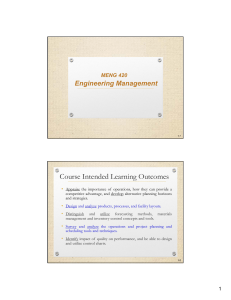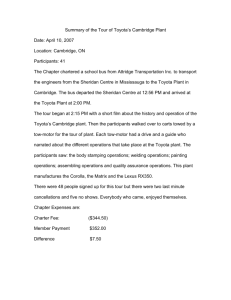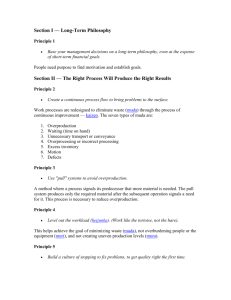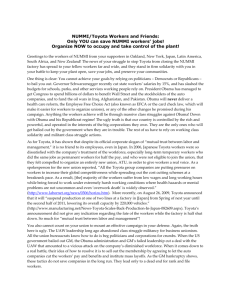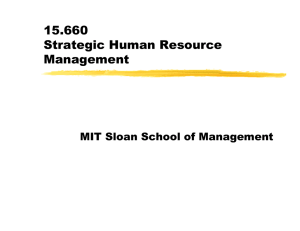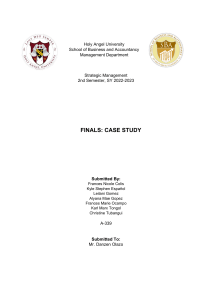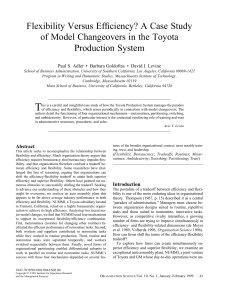File
advertisement
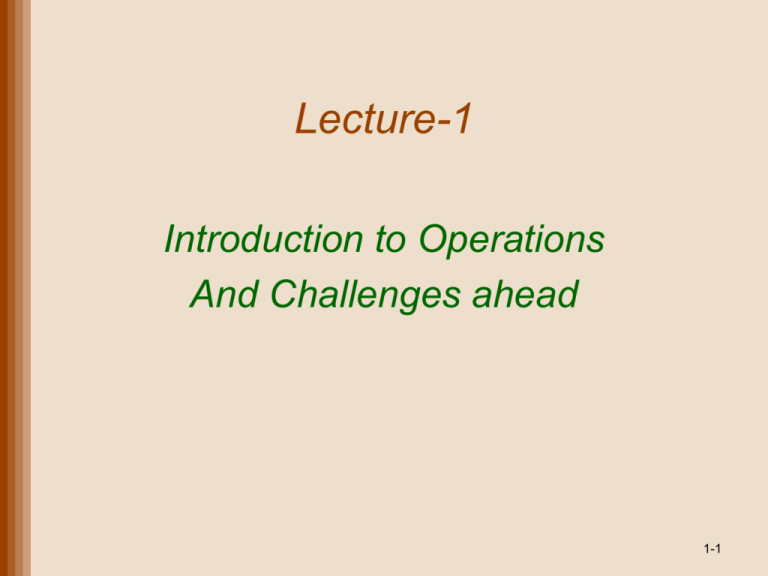
Lecture-1 Introduction to Operations And Challenges ahead 1-1 Lecture Outline • What Operations and Supply Chain Managers Do • Operations Function • Evolution of Operations and Supply Chain Management • Globalization and Competitiveness • Operations • Strategy and Organization of the Text • Learning Objectives for This Course Copyright 2011 John 1-2 What Operations and Supply Chain Managers Do • What is Operations Management? • Design, operation, and improvement of productive systems that creates and delivers the firm’s primary products and services • What is Operations? • a function or system that transforms inputs into outputs of greater value • What is a Transformation Process? • a series of activities along a value chain extending from supplier to customer • activities that do not add value are superfluous and should be eliminated Copyright 2011 John 1-3 Transformation Process • Physical: as in manufacturing operations • Locational: as in transportation or warehouse operations • Exchange: as in retail operations • Physiological: as in health care • Psychological: as in entertainment • Informational: as in communication 1-4 Operations as a Transformation Process INPUT •Material •Machines •Labor •Management •Capital TRANSFORMATION PROCESS OUTPUT •Goods •Services Feedback & Requirements 1-5 Operations Function • Operations • Marketing • Finance and Accounting • Human Resources • Outside Suppliers 1-6 How is Operations Relevant to your job? • Accounting • “As an auditor you must understand the fundamentals of operations management.” • Information Technology • “IT is a tool, and there’s no better place to apply it than in operations.” • Management • “We use so many things you learn in an operations class—scheduling, lean production, theory of constraints, and tons of quality tools.” 1-7 How is Operations Relevant to job career? • Economics • Marketing • Finance • “It’s all about processes. I live by flowcharts and Pareto analysis.” • “How can you do a good job marketing a product if you’re unsure of its quality or delivery status?” • “Most of our capital budgeting requests are from operations, and most of our cost savings, too.” 1-8 Evolution of Operations and Supply Chain Management • Craft production • process of handcrafting products or services for individual customers • Division of labor • dividing a job into a series of small tasks each performed by a different worker • Interchangeable parts • standardization of parts initially as replacement parts; enabled mass production 1-9 Evolution of Operations and Supply Chain Management • Scientific management • systematic analysis of work methods • Mass production • high-volume production of a standardized product for a mass market • Lean production • adaptation of mass production that prizes quality and flexibility 1-10 Historical Events in Operations Management Era Industrial Revolution Scientific Management Events/Concepts Dates Originator Steam engine Division of labor Interchangeable parts Principles of scientific management 1769 1776 1790 James Watt 1911 Frederick W. Taylor Time and motion studies 1911 Activity scheduling chart Moving assembly line 1912 1913 Adam Smith Eli Whitney Frank and Lillian Gilbreth Henry Gantt Henry Ford 1-11 Historical Events in Operations Management Era Human Relations Operations Research Events/Concepts Dates Originator Hawthorne studies 1930 1940s 1950s 1960s 1947 1951 Elton Mayo Abraham Maslow Frederick Herzberg Douglas McGregor George Dantzig Remington Rand 1950s Operations research groups 1960s, 1970s Joseph Orlicky, IBM and others Motivation theories Linear programming Digital computer Simulation, waiting line theory, decision theory, PERT/CPM MRP, EDI, EFT, CIM 1-12 Historical Events in Operations Management Era Events/Concepts JIT (just-in-time) TQM (total quality management) Strategy and Quality Revolution operations Dates Originator 1970s 1980s 1980s Reengineering 1990s Six Sigma 1990s Taiichi Ohno (Toyota) W. Edwards Deming, Joseph Juran Wickham Skinner, Robert Hayes Michael Hammer, James Champy GE, Motorola 1-13 Historical Events in Operations Management Era Events/Concepts Internet Revolution Internet, WWW, ERP, 1990s supply chain management Globalization Dates Originator E-commerce 2000s WTO, European Union, Global supply chains, Outsourcing, Service Science 1990s 2000s ARPANET, Tim Berners-Lee SAP, i2 Technologies, ORACLE, Dell Amazon, Yahoo, eBay, Google, and others China, India, emerging economies 1-14 Historical Events in Operations Management Era Events/Concepts Dates Originator Green Revolution Global warming, An Inconvenient Truth, Kyoto Today Numerous scientists, statesmen and governments 1-15 Evolution of Operations and Supply Chain Management • Supply chain management – management of the flow of information, products, and services across a network of customers, enterprises, and supply chain partners 1-16 Globalization • Why “go global”? – – – – – favorable cost access to international markets response to changes in demand reliable sources of supply latest trends and technologies • Increased globalization – results from the Internet and falling trade barriers 1-17 Hourly Compensation 1-18 GDP per Capita 1-19 Trade in Goods, % of GDP 1-20 Productivity and Competitiveness • Competitiveness • degree to which a nation can produce goods and services that meet the test of international markets • Productivity • ratio of output to input • Output • sales made, products produced, customers served, meals delivered, or calls answered • Input • labor hours, investment in equipment, material usage, or square footage 1-21 Measures of Productivity 1-22 Osborne Industries C6*C8 C7*C9 C5/C6 C5/C7 C5/C13 1-23 Productivity Growth 1-24 Percent Change in Input and Output 1-25 Strategy and Operations • • • • • How the mission of a company is accomplished Provides direction for achieving a mission Unites the organization Provides consistency in decisions Keeps organization moving in the right direction 1-26 Strategy Formulation 1. Defining a primary task • What is the firm in the business of doing? 2. Assessing core competencies • What does the firm do better than anyone else? 3. Determining order winners and order qualifiers • What qualifies an item to be considered for purchase? • What wins the order? 4. Positioning the firm • How will the firm compete? 5. Deploying the strategy 1-27 Strategic Planning Mission and Vision Corporate Strategy Marketing Strategy Operations Strategy Financial Strategy 1-28 Order Winners and Order Qualifiers Source: Adapted from Nigel Slack, Stuart Chambers, Robert Johnston, and Alan Betts, Operations and Process Management, Prentice Hall, 2006, p. 47 1-29 Positioning the Firm • • • • Cost Speed Quality Flexibility 1-30 Positioning the Firm: Cost • Waste elimination • relentlessly pursuing the removal of all waste • Examination of cost structure • looking at the entire cost structure for reduction potential • Lean production • providing low costs through disciplined operations 1-31 Positioning the Firm: Speed • Fast moves, Fast adaptations, Tight linkages • Internet • Customers expect immediate responses • Service organizations • always competed on speed (McDonald’s, LensCrafters, and Federal Express) • Manufacturers • time-based competition: build-to-order production and efficient supply chains • Fashion industry • two-week design-to-rack lead time of Spanish retailer, Zara 1-32 Positioning the Firm: Quality • Minimizing defect rates or conforming to design specifications • Ritz-Carlton - one customer at a time • Service system designed to “move heaven and earth” to satisfy customer • Employees empowered to satisfy a guest’s wish • Teams set objectives and devise quality action plans • Each hotel has a quality leader 1-33 Positioning the Firm: Flexibility • Ability to adjust to changes in product mix, production volume, or design • Mass customization: the mass production of customized parts • National Bicycle Industrial Company • offers 11,231,862 variations • delivers within two weeks at costs only 10% above standard models 1-34 Policy Deployment • Policy deployment • translates corporate strategy into measurable objectives • Hoshins • action plans generated from the policy deployment process 1-35 Policy Deployment Derivation of an Action Plan Using Policy Deployment 1-36 Balanced Scorecard • Balanced scorecard • measuring more than financial performance 1. finances 2. customers 3. processes 4. learning and growing • Key performance indicators • set of measures to help managers evaluate performance in critical areas 1-37 Balanced Scorecard Worksheet 1-38 Balanced Scorecard Radar Chart Dashboard 1-39 Operations Strategy Services Products Capacity Facilities Human Resources Sourcing Process and Technology Quality Operating Systems 1-40 Current Issues in the OM • Effectively consolidating the operations resulting from mergers: • Offers economies of scale and Operational Efficiency • In reality the difference in culture and technology a challenge • Hewett Packard and Compaq Computers • TRW and Northampton Computers • Develop flexible Supply Chain for mass customization • The challenge of producing so many diff products and also ensure it distribution • Managing global suppliers, production and distribution networks • Increased Commoditization of suppliers: • Long term supply contracts to switch over “ plug compatible • Achieving the Service factory: • Developing personalized service for each customer • Enhancing Value added services: • Advance knowledge of Model Changes required • Making Efficient use of internet technology 1-41 • Achieving good service from service firms. Case Study NUMMI 42 History/Products • Late 70’s oil crisis • GM closes Fremont, CA plant firing 6000 in 1982 • Toyota approaches GM to set up Toyota production system at a GM plant, United Auto Workers accepts the deal • GM and Toyota put together $400M in 1984. GM owns the infrastructure, Toyota is the tenant. • Nummi = New United Motor Manufacturing, Inc is born in 1984 as the unique example of a Toyota – GM joint venture • Products: Toyota Corolla, Tacoma Trucks, Pontiac Vibe (Toyota bottom, GM top) and Toyota Voltz (Toyota bottom, GM top, sold in Japan) , GM Prism until 13/12/01 43 Workers • Nummi has about 4500 unionized workers • Workers are under two types: • Production, high school graduates • Maintenance • Workers work in teams of 4-6 • Workers in a team rotate the tasks every 1-3 hours • Team leader is responsible for the rotation. • Team leader withdraws parts from the inventory (every 12 hours) and provides the tools as necessary • Workers make $17 per hour 44 Capacity • Nummi has a cycle time of • 60 seconds for Corolla, 1 body • 82 seconds for Tacoma, 3 bodies (only cabin is produced at Nummi, the bottom and the back are bought from suppliers) • Nummi works in two shifts • I: 6:00-14:30, II: 16:30-1:00 • Each shift has 1 hour lunch/dinner break • Starting the first shift at 6:00 workers avoid heavy morning traffic • Two hours between shifts I and II is to allow for overtime after the first shift when necessary 45 Work Flow • Stamping: Forming metal (side, back, front) panels with presses • Body & Weld: Putting panels together • Paint: Paint inspection is the current bottleneck • Primer body paint applied by robots (chemically hazardous task) • Door jambs painted manually • Plastics: Making bumpers, inside panels • Assembly: Putting in tires, engine, seats, bumpers, harnessing. Cars , trucks on 2 km , 0.8 km conveyors • Cars contain Building manifest = BOM = Ingredients list at every step of these operations 46 Just in time • Kaizen: continuous improvement • Kanban: replenishment every 1-2 hours • Jidoka: Assure 100% quality. Otherwise pull the Andon chord • 1000 times per shift • 9% of line stops are longer than 30 seconds • Line stops longer than an hour once every month • Muda: Waste to be eliminated • Genchi Genbutsu: Go to the source to learn and to solve the problems • This Japanese terminology is all over the boards in the plant 47 Creative Tool / Work Place Design • Die change at the stamping in 3 hours • Tilted storage bins for ease of access • Collapsing storage boxes when empty • To reduce the empty box storage requirements in trucks returning to suppliers, say in Indiana • These boxes save about $10M annually • The worker who suggested the boxes earned several thousand points. 1 point = $1. • More info www.nummi.com 48
